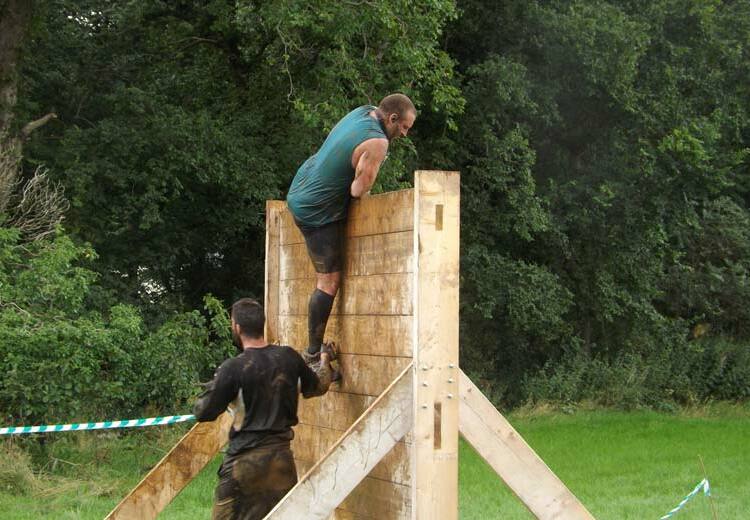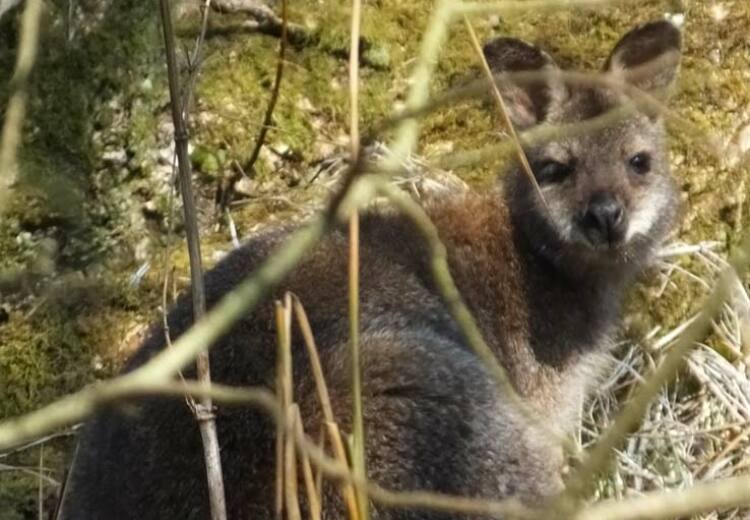
Manx, together with all the other Celtic languages, often changes the initial consonant of a word. This is called 'mutation' and follows grammatical rules. Thus mutation occurs, for example, in the adjective following a feminine singular noun, and after ordinal numbers: mie 'good' but ben vie 'a good woman'; tree punt 'three pounds' but yn trass phunt 'the third pound'. Two main types of mutation occur, called 'lenition' and 'nasalisation' (formerly and less correctly known as 'aspiration' and 'eclipsis' respectively), the type depending on the grammatical context, so that the same word may at various times assume two other forms: kayt 'a cat', my chayt 'my cat', nyn gayt 'our cat'.
Dictionary Letter Lenition and Nasalisation
- B V,W M
- C,K CH G
- ÇH H J
- D GH GH (pronounced 'n')
- F (disappears) V
- G GH GH, N'GH (pron. 'ng')
- J Y N'Y
- M V,W M
- P PH B
- QU WH GW
- S H.T S
- T H D
Where a consonant would normally undergo nasalisation, a vowel remains unchanged but prefixes n- after a vowel. Similarly, in a position where a consonant lenites, a vowel may prefix h- after another vowel.
Throughout the centuries the mutations, which originally came about for phonetic reasons, are now mainly determined by grammatical considerations.
There are two genders in Manx, masculine and feminine, though a number of nouns are of indeterminate gender; these may for all practical purposes be regarded as masculine.
The plural of nouns may be formed in various ways, the most common of which are:
- by adding -yn: thie 'house', pl. thieyn
- by changing final -agh to -ee: imbagh 'season', pl. imbee
- by changing -ey to -aghyn: garey 'garden', pl. garaghyn
- by changing the root vowel: boayrd 'table', pl. buird
- Several other plural endings occur with less frequency, e.g. -eeyn, -nyn, -jyn, -inyn, and some nouns are quite irregular: teen 'woman, pl. mraane; slieau 'mountain', pl. sleityn; dooinney 'man', pl. deiney.
There are nowadays only two cases in Manx, the nominative and the genitive, the form of the latter being distinct in only a small number of nouns (mostly feminine), e.g. blein 'year', gent bleeaney, though many more old genitival forms still survive in a quasi-adjectival capacity:
clagh 'stone', trimmid y chlagh 'the weight of the stone', but cleigh cloaie 'a stone walk (=wall of stone). A few datives still survive in crystallised expressions: cass 'foot', ry-chosh 'by foot'; beeal 'mouth', cheu-my-veealloo ' in front of me'.
Article
There is no indefinite article in Manx. The definite article in the singular is yn (usually found as 'n after a vowel and y between consonants), the plural being ny. The feminine genitive singular article is also ny, though this usually only occurs before a noun having a distinct genitive form: kione ny bleeaney '(the) end (of) the year'.
In the plural the article is ny for both genders and cases. When the following noun begins with a vowel it may prefix h, this also applying when ny precedes a genitive singular feminine noun; the inserted h is often omitted in writing but not in speech.
The following examples may serve to illustrate the articles in use; it will be seen that lenition takes place in the masculine genitive singular and feminine nominative singular:
- yn braar 'the brother' yn vraarey 'of the brother'
- ny braaraghyn 'the brothers' 'of the brothers
- yn shuyr 'the sister' ny shayrey 'of the sister'
- ny shayraghyn 'the sisters', 'of the sisters'
Adjectives
With very few exceptions adjectives follow the noun to which they refer and are lenited in the feminine singular. Apart from a few common adjectives of one syllable they do not change in the plural:
- dooinney mie 'a good man'
- ben vie 'a good woman'
- deiney mie 'good men'
- mraane mie 'good women'
- slieau ard 'a high mountain'
- sleityn ardey 'high mountains'
Manx does not differentiate between the comparative and superlative forms, the meaning normally being clear by the context:
- mraane share 'better (or best) women'
- ny mreane share 'the better (or best) women'
Most of the possessive adjectives mutate the following noun:
- my hie 'my house'
- dty hie e hie 'his house'
- e thie nyn dhie 'our (your, their) house' 'your house' (sg.) 'her house'
Because of the ambiguity of nyn dhie a colloquial alternative developed:
- yn thie ain 'our house'
- yn thie eu 'your house'
- yn thie oc 'their house' (lit. 'the house at-us, at-you, at-them' respectively), and this construction also became popular in the singular (e.g. yn thie echey 'his house', 'the house at-him')
Demonstrative adjectives are three in number and follow the article and noun; they remain unchanged in the plural:
- yn thalloo shoh 'this land'
- yn cronk shen 'that hill'
- yn slieau shid 'that (distant) mountain'
- ny sleityn shid 'those (distant) mountains'
Prepositions
Manx, in common with the other Celtic languages, combines a preposition and following pronoun into one word: er 'on', but orrym 'on me' ort 'on you' (sg.), er 'on him', urree 'on her', orrin 'on us', erriu 'on you'(pl.), orroo 'on them'. The simple form of the preposition usually coincides with the masculine singular form, as may be seen here. Manx also has a number of prepositional phrases, e.g. my-dty-chione 'about (concerning) you' (lit. 'about your head'). Extra endings may be added for emphasis: orms 'on me', erriuish 'on you', my-nyn gionesyn 'about them'.
Numerals
1 unnane, 'nane, 2 jees, 3 three, 4 kiare, 5 queig, 6 shey, 7 shiaght, 8 hoght, 9 nuy, 10 jeih.
When preceding a noun, 'one' is n and 'two' is daa, both causing lenition. The teens generally add - jeig: 16 shey-jeig. In Manx the score system is used, so after feed 'twenty', we have 40 daaed (=daa 'eed), 60 tree feed, and so on up to 180 nuy feed, though keead is normally used for one hundred. The following examples will serve to show how numbers between the round scores are made: 23 three as feed, 37 shiaght-jeig as feed ('seventeen and twenty'), 51 'nane-jeig as daeed. After 60 the larger element precedes, e.g. 148 shiaght feed as hoght, 229 daa cheead nuy as feed. 1,000 thousane.
Ordinal numerals are formed by adding -oo to numbers after three (the ordinals 1st to 3rd are irregular). All cause lenition, and many are themselves lenited after yn: yn nah hie 'the second house', yn wheiggoo chronk 'the fifth hill'.
Adverbs
Derived adverbs are made by putting dy before the relevant adjective: tappee 'quick', dy tappee 'quickly'.
Both adverbs and adjectives form their comparative/superlative identically, i.e. by prefixing s' preceded by the word ny: ny s'tappee 'quicker', 'quickest', 'more quickly', 'most quickly'. There are many irregular forms, especially for high-frequency monosyllabic adjectives and adverbs, e.g. mie 'good', ny share 'better','best'. When an adjective is attributive ny is omitted: yn thie sloo 'the smaller/smallest house'.
Pronouns
Like most European languages, Manx uses two different pronouns for 'you', oo for the familiar singular form and shiu in all other situations. However, one form of each pronoun serves as both subject and object: honnick eh eh 'he saw him'.
There are no real relative pronouns, and relative clauses follow the English pattern 'the woman you spoke to is here'.
Word Order
The most striking difference between the Celtic languages and English is that in the former the verb is normally the first word in the sentence unless preceded by a negative or some other particle: t'eh cloie 'sy gharey 'he is playing in the garden' (lit. 'is he...').
For questions, unlike English, it is the verb which undergoes change, not the word order.
As already mentioned, most adjectives follow the noun they describe, and a demonstrative adjective will follow any others: yn kayt doo shen 'that black cat' (='the cat black that').
When an adverb is used with any tense of the verb ve 'to be' followed by a verh-noun (e.g. 'I am running' as opposed to~rl ran'), it is usually placed between the finite verb and the verb-noun: t'ad dy kinjagh ginsh dou 'they are always telling me'.
When any part of the sentence is to be given special emphasis it is placed first: jea haink ee dy chur shilley orrym 'yesterday it was that she came to visit me'.
Verbs
As in English verbs in the past, future and conditional tenses have two forms, e.g 'I ran, I was running', and the continuous form is obtained by using the appropriate part of the irregular verb ve 'be' with what is called the verb-noun, roughly corresponding to the English gerund. The present tense has only a continuous form, and this is used even when a momentary action is concerned: ta mee goll shagh ee dagh laa 'I pass her every day' (='I am going past her...').
The non-continuous form in the other tenses is formed by inflecting and/or mutating the verbal stem, so from the stem cum 'hold' we can say chum mee 'I held', cummym 'I shall hold', chummin 'I would hold'. If an inflexion is added for the 'I' form, a different inflexion is used for all the other persons singular and plural, the appropriate pronoun being used to distinguish between them: cummee eh, shiu, ad 'he, you, they will hold'.
As an alternative to this system, the appropriate part of the irregular verb jannoo 'do' may be used with the verb-noun, the meaning being exactly the same: nee'm cummal 'I shall hold', yinnin cummal 'I would hold', nee shiu / yinnagh shiu cummal 'you will / would hold'. This alternative even applies to the imperative: cum or jean cummal 'hold!'
When a verb is used in the interrogative form, it is no longer preceded by the ancient particle an, which still exists in the other Gaelic languages. Nevertheless, the mutations formerly caused by this particle still remain: cummym 'I shall hold', gummym? 'shall I hold?' Particles such as an and cha 'not' preceded a special form of the verb which is called the 'dependent' form as opposed to the 'ahsolute' form used for positive statements.In regular verbs the absolute and depenaent are often identical (e.g. in the past tense, chum eh 'he held', chum eh? 'did he hold?') or only distinguished by a different inflexion (e.g. in the future, chummee eh 'he will hold', gum eh' 'will he hold?'), whereas the irregular verbs, of which there are ten, often have apparently unrelated absolute and dependent forms (e.g. va mee 'I was', row mee? 'was I?', honnick shin 'we saw', vaik shin? 'did we see?'). It is by using separate forms for the statement and the question that Manx is able to keep to its usual 'verb first' word order, but when the two forms are identical only the intonation of the voice can distinguish statement from question, and it is most often in the past tense that this applies.
Whilst no difference of meaning exists between the inflected tense form and the 'periphrastic' form comprising jannoo in its appropriate tense and the verb-noun, the former is met with more often in the past tense than in the future or conditional and in the ten irregular verbs more readily than in the regular verbs. As its use in the spoken language requires considerable practice, it is usually replaced by the periphrastic forms colloquially, especially in late native speaker Manx, where inflected forms, though always understood, were seldom used. Prose written since the revival of the language (especially that of J. J. Kneen) uses a much greater preponderance of inflected forms than most written Manx from earlier times, this enabling a more formal literary style to exist alongside the simpler conversational or narrative style.
Manx also has a number of verbal phrases, and often uses them in places where English has a simple verb e.g. 'I like' is rendered by the phrase s'mie lhiam (='is good with-me';. The verb s' (Gaelic is) is actually related to the English 'is' but is limited in use to this type of verbal phrase and when an adjective is given special emphasis at the beginning of the sentence or is in the comparative/superlative form. The present tense s' also serves as the future, whilst by (b' before a vowel) is both past tense and conditional: by vie lhee 'she liked/would like' (='was/would be good with-her'). The object of the English sentence then becomes the subject of the Manx: s'olk lesh fuirraghtyn 'he does not like waiting' (='is bad with-him waiting', i.e. waiting is bad with him).
S' combines with the pronoun eh 'he','it' to form she. and this is used at the beginning of a sentence immediately before any noun, pronoun non-derived adverb or verb requiring special emphasis, in this context it is not tied to any particular tense, and the tense of the sentence is indicated by the main verb: she dty naunt loayr rhym 'it was your aunt who spoke to me' (='it- is your aunt [who] spoke with-me'); she mairagh ragh shin 'it is tomorrow we would go'.
You may also be interested in
Manx Grammar - Tenses
How to indicate the past or present in Manx.








